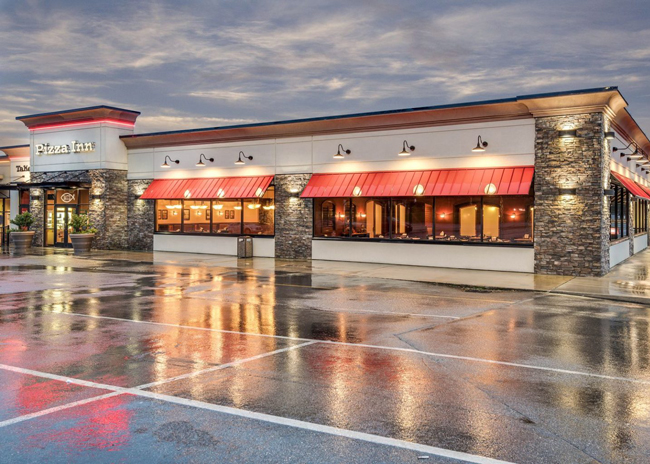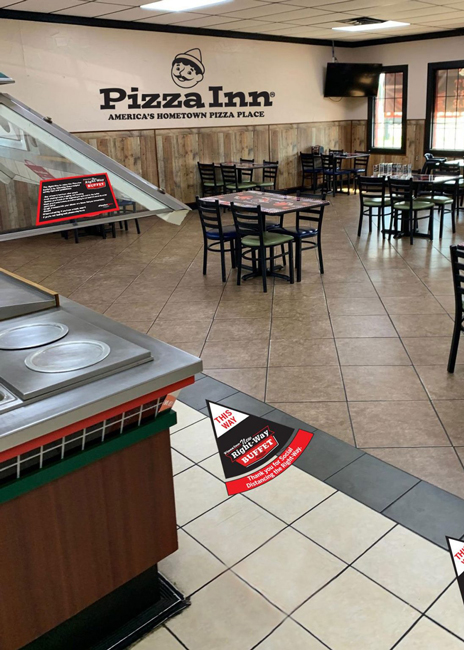One presumed outcome of the COVID-19 pandemic is the demise of self-service options like buffets and salad bars. Through thoughtful hard work and collaboration, though, one restaurant chain is doing what it can to ensure its self-serve options continue to thrive once guests return for on-premises dining.
 That’s because for Pizza Inn, the buffet was a cornerstone of the chain’s dining options prior to state and local governments turning out the lights on restaurant dining rooms across the country to slow the spread of coronavirus. “We could go without a buffet temporarily and have done takeout, delivery and curbside delivery,” says Justin Smith, senior director of operations. “But not having a buffet was a non-starter for us. We had to figure out a way to welcome our customers back and make it safe for them.”
That’s because for Pizza Inn, the buffet was a cornerstone of the chain’s dining options prior to state and local governments turning out the lights on restaurant dining rooms across the country to slow the spread of coronavirus. “We could go without a buffet temporarily and have done takeout, delivery and curbside delivery,” says Justin Smith, senior director of operations. “But not having a buffet was a non-starter for us. We had to figure out a way to welcome our customers back and make it safe for them.”
From that came the chain’s New Right Way Buffet. “We developed this fairly quickly, working with our operations team, marketing team, executives from RAVE Restaurant Group, our parent company, and our franchise leadership council,” says Smith. “We developed a plan that felt would work well and presented our food well. The franchisees are appreciative of our getting their feedback and they provided plenty of different perspectives.”
Buffet traffic at Pizza Inn locations will be one-way to adhere to social distancing guidelines. At some locations where the layout allows, the restaurant will change the model and staff will serve guests food cafeteria-style. At other locations, team members will serve guests at their tables. In addition, the salad bar will look different by location, depending on local or state regulations. Some salads will be grab-and-go, when allowed by the local health department, or served tableside. At locations with a fully operational salad bar, guests will receive gloves or sanitizer, and Pizza Inn staff will change utensils after each guest.
Changes, though, will go beyond the buffets. For example, the chain has closed self-serve beverage stations, meaning staff will now bring drinks to guests at their tables. In addition, team members will now provide table service for items like plates, silverware, napkins and condiments. Previously, guests would help themselves to these items when visiting Pizza Inn. Some locations will offer guests the option to pay their tabs tableside, too.
 Pizza Inn has added sanitation stations throughout the restaurant to help encourage a more sanitary experience. Each buffet will also have what the chain calls a Sanitizer Captain. This staff member oversees upholding the restaurant’s cleaning and sanitation standards. Further, all Pizza Inn staff members will wear safety masks and gloves.
Pizza Inn has added sanitation stations throughout the restaurant to help encourage a more sanitary experience. Each buffet will also have what the chain calls a Sanitizer Captain. This staff member oversees upholding the restaurant’s cleaning and sanitation standards. Further, all Pizza Inn staff members will wear safety masks and gloves.
On the front end, an approach like this may require more labor but over the long haul, Smith thinks that will level off. “Initially it is going to take a couple more people because it’s a new model,” he says. “But we have a lot of tenure and leadership in our restaurants. Once they do it for a few weeks, I bet it will be mostly labor neutral. But it will require an investment up front to make sure the guest gets that great experience.”
Smith also points out the buffet style of service requires a certain amount of volume to be effective. “Most of our restaurants are able to make it work at 50% capacity,” he says. “Obviously, we would love to be at 100% capacity. For most restaurants, 50% capacity is doable, except for prime times like Friday nights.” In the cases where local ordinances allow dining rooms to operate but at less than 50% capacity, Pizza Inn has made some adjustments. Those locations offer a limited menu that staff serve to guests tableside, Smith says.
Pizza Inn’s affiliation with RAVE was pivotal in this process. “It gives you another perspective and you can learn from what other people in our company are doing,” Smith says. “We have the chance to bounce things off one another. Even though we are a big brand, we have all these other restaurant owners working with us in the form of franchisees and being able to talk with them about what’s working and what is not is really helpful.”
As of now, 60% of Pizza Inn’s restaurants are open for dine-in service, while others wait for their states to transition into the next phase of their reopening plans. “We are looking forward to our restaurants in North Carolina reopening soon,” Smith says. “Once we can open more fully, we will do some guest research to see how they feel. Sales are a big indicator, too. But a lot of this will be based on the consumer and their reaction to this.”
Like most every other restaurant concept across the country, Pizza Inn had to change its approach to off-premises due to dining room closures aimed at slowing the spread of COVID-19. In March, for example, Pizza Inn unveiled its Contactless Buffet to Go approach, which includes three different combinations of appetizers, pizzas and desserts from the chain’s regular buffet. This was available by delivery or guests could come to a Pizza Inn location to collect their orders.
“Our Contactless Buffet to Go really helped us in the delivery space but it’s been a mixed bag across the brand,” Smith says. “The stores with a pickup window or offering delivery were doing better a little quicker. Customers have told us they want our product and they were able to help us, too.”
Some Pizza Inn franchisees took this time of reduced customer traffic to close their restaurants completely to remodel, Smith adds. “They did so voluntarily.”



